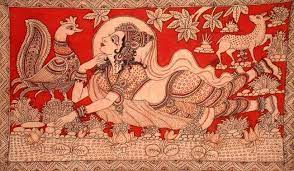Kalamkari painting is a traditional Indian art form derived from the words “kalam” (pen) and “kari” (work), Kalamkari art involves hand-painted designs on fabrics using natural dyes. In this article, we delve into the origins, techniques, and significance of Kalamkari painting.

Origins of Kalamkari Painting
Kalamkari painting finds its roots in ancient India, dating back over 3000 years. It originated in the region of Andhra Pradesh, particularly in the towns of Machilipatnam and Srikalahasti. Initially, Kalamkari was practiced on temple walls, depicting mythological stories and religious motifs. Over time, this art form evolved to adorn textiles, such as sarees, dupattas, and wall hangings.
Techniques and Process
Artists employ two distinct techniques: Srikalahasti style and Machilipatnam style.
- Srikalahasti style: This technique involves using a pen-like tool called a kalam, made from bamboo or date palm sticks. Artists dip the kalam into natural dyes made from plants, minerals, and organic materials. They then delicately trace the design on the fabric, displaying remarkable precision and control.
- Machilipatnam style: In this style, artists use a combination of hand-painting and block-printing methods. Intricate hand-painted details are complemented by carved wooden blocks, which are dipped in natural dyes and carefully pressed onto the fabric. This technique allows for larger patterns and intricate designs.
Significance and Themes
Kalamkari paintings often depict mythological stories, epic narratives, and scenes from ancient texts like the Ramayana and Mahabharata. The intricate artwork captures the essence of Indian culture and spirituality. Each painting tells a story, with vibrant colors and intricate detailing bringing the narrative to life. From the delicate lines to the intricate motifs, Kalamkari paintings showcase the artist’s skill and their connection with traditional tales.
Q. Kalamkari painting refers to
(a) a hand-painted cotton textile in South India
(b) a handmade drawing on bamboo handicrafts in North-East India
(c) a block-painted woollen cloth in Western Himalayan region of India
(d) a hand-painted decorative silk cloth in North-Western India
UPSC Prelims 2015
Ans: (a)
Kalamkari painting is the painting done with the pen. These paintings are done in Andhra Pradesh. Vegetable dyes are used for color in Kalamkari painting. The painting flourished during the Vijayanagar Empire. The painting was used for decorating the interior of the temple. The subject of the Kalamkari is Hindu mythology. The legacy of this art is transferred from father to son. The boundary of the paining is decorated with floral decorative pattern. These paintings are made on the cloth.
Important Links